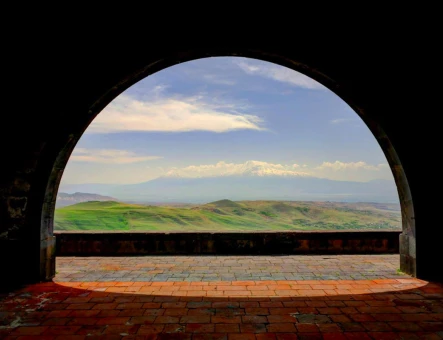Private tour: Garni Temple, Geghard Monastery, Garni Canyon Symphony of stones, Lavash baking master class
Arch of Charents, Garni Temple, Symphony of stones, Geghard Monastery, Lavash baking master class
1. Arch of Charents
15-20 min





You can make here stunning pictures against the backdrop of the Arch and Mountain Ararat, only the weather should be clear.
2. Garni Temple
60-70 min

























3. Garni Canyon Symphony of stones
30-35 min



















4. Geghard Monastery
60-70 min
































Lavash baking master class
15-20 min

















Lavash is one of the most popular gastronomic icons of Armenia, serving as an integral part of the Armenian cuisine. It is a traditional soft, thin flatbread, made in tonir (special ground oven). Although the baking process of lavash requires much of special skills, it is undertaken by women. For centuries lavash has been consumed by all classes of Armenian society, it is valued for the unique taste and the ability to be stored for quite a long period of time without losing its positive qualities.
In 2014 "The preparation, meaning and appearance of traditional bread lavash as an expression of Armenian culture" was inscribed in the UNESCO Representative List of the Intangible Cultural Heritage of Humanity.
During this master class you will observe and learn the millennia-old techniques of making lavash, and, of course, taste self-baked lavash together with some fresh greens and yummy local cheese. Feeling the smell of lavash once, you will save this impression for the whole life:)
Inclusions
-
Professional drivers
-
Air-conditioned vehicles
-
Bottled water
-
Free pick-up & drop-off within Yerevan
-
Vehicle & passengers insurance
-
Extra stops on the route upon request
Exclusions
-
Significant deviations from the route
-
Alcoholic beverages if lunch option selected
-
Audio guides
-
Wi-Fi in the vehicles
What to expect
- Wonder at the views of Biblical Mount Ararat from Charents arch
- Explore the 1st century pagan temple
- Explore stunning geological monuments, named "Basaltic Organ"
- Discover the legends of St. Lance used by the roman soldier to sting Jesus Christ's side
- Taste most delicious Armenian traditional bread
Booking conditions
Cancellation & modification
Meet our Guides

Raffi Halajian
I'm Raffi, and I'm happy to meet you and be your friend during your tour in Armenia. Being born Armenian and having lived in Syria, my work as a tour guide holds special meaning for my guests. I share the experiences of Armenians living abroad and how they have managed to preserve their heritage there.

Anush Gevorgyan
With a deep love for my country and a true passion for storytelling, I bring every tour to life through enthusiasm and local insights. Whether it's uncovering hidden gems or sharing fascinating history, I make every experience unforgettable. Join me on a journey filled with culture, adventure, and authentic moments – you'll leave with amazing memories and a new appreciation for this beautiful destination!

Liana Karapetyan
I am Liana Karapetyan – for Italians, Liliana. I have many years of experience as a tour guide and even longer experience as an Italian language translator. Why choose me? If you want to create unforgettable memories from your trip to Armenia, I am ready to help you do so.

Anna Martirosyan
Hi everyone! I'm Anna, and I've been working as a tour guide since 2013. If you're ready to discover Armenia, I'll turn it into an exciting and unforgettable journey. My tours offer a full immersion into the culture, history, religion, and traditions of the Armenian people. My goal is that by the end of your trip, you'll fall in love with Armenia and want to come back again!



